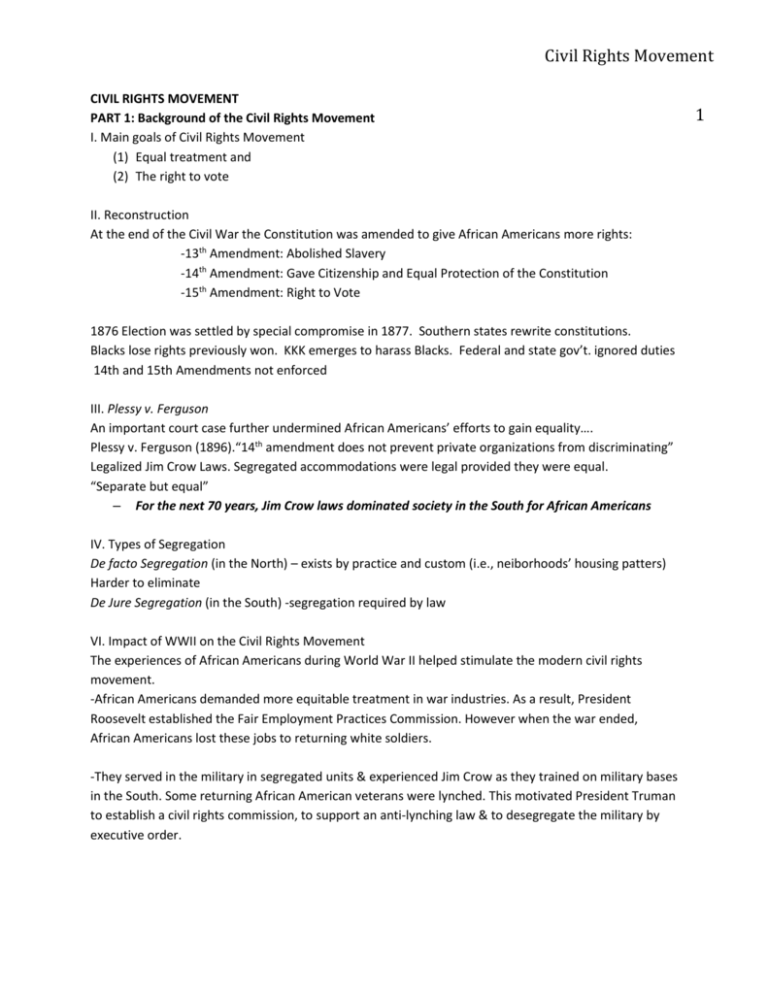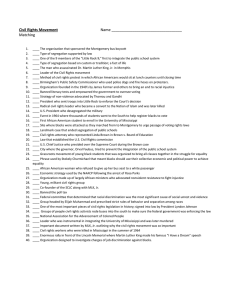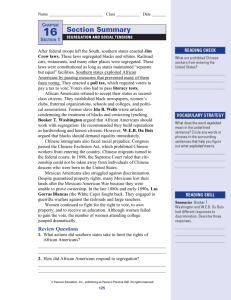Civil Rights Movement - Anderson School District Five
advertisement

Civil Rights Movement CIVIL RIGHTS MOVEMENT PART 1: Background of the Civil Rights Movement I. Main goals of Civil Rights Movement (1) Equal treatment and (2) The right to vote II. Reconstruction At the end of the Civil War the Constitution was amended to give African Americans more rights: -13th Amendment: Abolished Slavery -14th Amendment: Gave Citizenship and Equal Protection of the Constitution -15th Amendment: Right to Vote 1876 Election was settled by special compromise in 1877. Southern states rewrite constitutions. Blacks lose rights previously won. KKK emerges to harass Blacks. Federal and state gov’t. ignored duties 14th and 15th Amendments not enforced III. Plessy v. Ferguson An important court case further undermined African Americans’ efforts to gain equality…. Plessy v. Ferguson (1896).“14th amendment does not prevent private organizations from discriminating” Legalized Jim Crow Laws. Segregated accommodations were legal provided they were equal. “Separate but equal” – For the next 70 years, Jim Crow laws dominated society in the South for African Americans IV. Types of Segregation De facto Segregation (in the North) – exists by practice and custom (i.e., neiborhoods’ housing patters) Harder to eliminate De Jure Segregation (in the South) -segregation required by law VI. Impact of WWII on the Civil Rights Movement The experiences of African Americans during World War II helped stimulate the modern civil rights movement. -African Americans demanded more equitable treatment in war industries. As a result, President Roosevelt established the Fair Employment Practices Commission. However when the war ended, African Americans lost these jobs to returning white soldiers. -They served in the military in segregated units & experienced Jim Crow as they trained on military bases in the South. Some returning African American veterans were lynched. This motivated President Truman to establish a civil rights commission, to support an anti-lynching law & to desegregate the military by executive order. 1 Civil Rights Movement VII. The Cold War required a strong united military force. The containment policy required that the U.S. gain the support of emerging nations in Asia & Africa. Strategies used by the civil rights movement forced the US to live up to its constitutional promises or face embarrassment on the international stage. Part 2: The Civil Rights Movement and its Leaders TACTICS OF THE CIVIL RIGHTS MOVEMENT (1) Use of the court system by groups like the NAACP (2) Direct, nonviolent methods to confront discrimination and racism in the late 1950s and early 1960s. – Boycotts – Sit-ins – Freedom Rides Many of these non-violent strategies used were based on those of Mohandas Gandhi—a leader in India’s struggle for independence from Great Britain. American civil rights leaders such as Martin Luther King Jr. shared Gandhi’s views. 1. Use of the court system May 17, 1954 African American girl sued for the right to go to the school of her choice – and WON! Ruling overturned the ruling in Plessy v. Ferguson case and outlawed segregation in public schools Supreme Court unanimously decided segregation violates the 14th amendment. Separate educational facilities are inherently unequal. NAACP attorney Thurgood Marshall (center) argued the case to end segregation. Marshall later became the first African American on the Supreme Court. Results of Brown v. Board: • Most of the South did not voluntarily desegregate even after the Brown decision • Some governors stalled for a decade • President will have to risk political support and enforce Court’s ruling 2 Civil Rights Movement 2. Non-violent civil disobedience Sites were selected to show to the nation and world the face of racism in order to get the support of the voters for government assistance in securing civil rights. a. The Movement Begins Rosa Parks refuses to leave her seat for a white man & move to the back of the bus. Parks is arrested for violating city’s segregation law, leading to the… b. Montgomery Bus Boycott Outraged over Park’s arrest, African Americans organize a boycott of Montgomery’s Public Transportation System in 1956. African Americans carpooled, took taxis, or walked to avoid taking the bus. It worked! Montgomery forced to integrate buses. c. Emergence of MLK The person who led the Montgomery Bus Boycott was a Baptist minister from Atlanta, MLK. The boycott of the busing system of Montgomery gained King national prominence. Often compared to Mohandas Gandhi. Advocated non-violent protests. Urged followers to disobey unjust laws (civil disobedience). Was arrested 30 times d. Marches Marches were the most common form of protests used during the Civil Rights Movement. Protestors would march peacefully in attempt to draw national attention for their cause. e. Sit-ins Blacks were denied service at lunch counters. They sat at the counter until they were served or arrested Students who participated in the sit-ins refused to become violent. Sit-ins raised the awareness of the discrimination that was occurring f. Freedom Riders Blacks and whites traveled into the South to draw attention to the South’s segregation of bus terminals. When Freedom Riders arrived at various cities in the South, white mobs attacked them. Brought desegregation of some bus terminals. Perhaps more importantly, drew attention to the cause of civil rights. g. Birmingham Most segregated big city in America . MLK asked to come to the city. Test nonviolence--It was a planned non-violent campaign. Police Commissioner “Bull” Connor decided to crush the protest Police used fire hoses, police dogs and clubs. TV carried scene to the nation. MLK arrested. Leaders felt MLK was pushing too hard/too fast. Response “Letters from Birmingham Jail”. Kids march, 1000 arrested. 3 Civil Rights Movement Result: End to segregation in Birmingham. HUGE victory. Kennedy on TV asked Congress to pass a Civil Rights Bill. Nation saw racism in the South at its worst (effective use of media to draw attention to racism) h. March on Washington To support to President Kennedy’s Civil Rights bill, Martin Luther King, Jr., organized a massive march on Washington, D.C., as a show of support for the bill. On August 28, 1963, more than 200,000 demonstrators gathered peacefully at the nation’s capital. It was during the March on Washington in 1963 that Martin Luther King, Jr., gave his “I Have a Dream” speech. Dr. King presented his dream of freedom and equality for all Americans. The March on Washington and Martin Luther King’s speech helped to lead to the the Civil Rights Act (1964) & the National Voting Rights Act (1965). i. Freedom Summer (1964) Campaign to register Blacks in Mississippi to vote known as Freedom Summer. Arrival of hundreds of volunteers was met with massive violence. j. Selma to Montgomery marches - three marches in 1965 that marked the political & emotional peak of the American Civil Rights Movement. They were the culmination of the voting rights movement in Selma, Alabama, brought many prominent Civil Rights leaders (including MLK). The first march took placse on March 7, 1965 - "Bloody Sunday" - when 600 marchers were attacked by state & local police. The second march took place on March 9. Only the third march, which began on March 21 and lasted five days, made it to Montgomery, 54 miles (87 km) away. - A focus on the role of the media, especially television, helped to link the Civil Rights Movement to the popular culture of the post WWII era. Part 3: Civil Rights Legislation 1. Moving towards civil rights legislation The non-violent, direct action campaign of the Civil Rights Movement was successful in getting presidential support and the majority of the voting public in the early 1960’s. -Truman: Integrated the military. Truman’s advocacy of civil rights led to the emergency of the “Dixiecrats.” -Eisenhower: Helped to ensure integration in schools -JFK: Promoted civil rights bill 2. Civil Rights Act of 1964 Three months after the March on Washington President Kennedy was assassinated (November 22, 1963). Bill wasn’t close to passing. Johnson addressed Congress “…couldn’t more eloquently honor Pres. Kennedy’s memory.” Civil Rights Act of 1964 passed in June 1964 4 Civil Rights Movement - This act gave the “equal protection of the laws” clause of the 14th Amendment greater influence. - Segregation in public facilities became illegal. - Discrimination in education and employment. 3. 24th Amendment The 24th Amendment, ratified in 1964, helped to guarantee the right to vote for African Americans. It abolished poll taxes, which were fees that had to be paid in order to vote in national elections 4. Voting Rights Act (1965) The violence in Selma infuriated President Johnson and led to the federal government to step in again. It gave the federal government the power to ensure that voting was fair & free of discrimination. - The act also abolished mandatory literacy tests & other efforts to prevent blacks from voting. - The Voting Rights Act had a tremendous effect in S.C. as federal marshals monitored the registration of blacks in several counties. - In 1958, there were 58,000 registered black voters in the state, & in 1970 there were 220,000. 5. Civil Rights Act of 1968 Banned discrimination in housing. 6. Political Effects of Civil Rights Movement Democrats JFK and Johnson (LBJ) supported civil rights legislation. This, along with President Nixon (Republican) pursuing a Southern strategy of attracting conservative Southern democrats by appealing to their dissatisfaction with desegregation and a liberal Supreme Court, turned a formerly solid Democratic south in to a Republican stronghold. Part 4: Different approaches to civil rights leadership - South – philosophy of peaceful, nonviolent protest (on the protesters behalf). -North (urban areas) – televised reports of urban riots & the radical speech of the black power movement alienated the general public & undermined support for further government action to help African Americans. 1. Riots Frustration over poverty, slow change, and police treatment. Inner-city ghettos erupt in violence with small spark“burn baby burn” to prove a point. Rochester and NYC in 1964. Watts in 1965. Detroit in 1967. Many other cities after the assassination of MLK in 1968. Riots set cities back for decades as businesses destroyed were rebuilt elsewhere, people moved away, and damage not cleaned up in timely fashion 2. MALCOLM X Views totally different from Martin Luther King . “Meet violence with violence” Supported separatism over integration. Whites were the cause of African Americans’ living conditions. 5 Civil Rights Movement Kicked out of the Nation of Islam by Elijah Mohammed ’63. Softened stance about White race Saw many good White people on religious pilgrimage. Less outspoken of MLK. Assassinated in 1965 in Harlem Probably by members of Nation of Islam 3. BLACK POWER Coined by Stokley Carmichael . Encouraged pride in heritage. Wanted separate black economic/political institutions. Self defense against white violence. Symbolized by raised fist 4. BLACK PANTHERS • Organized to fight police brutality in the ghettos • Wanted self sufficiency for African American Communities, employment, good housing, and exemption from military service • Although they had some violent encounters with police and preached violent revolution, they also provided social services for community like: day-care, free breakfast program and afterschool programs in Afro-Centric education PART 5: IMPACT OF CIVIL RIGHTS MOVEMENT 1.) Women – worked to gain support of the government & the public to obtain women’s rights. Rejected traditional gender roles and advocated equality between men and women. - The Feminine Mystique, published 25 February 1963: book written by Betty Friedan which brought to light the lack of fulfillment in many women's lives, which was generally kept hidden. According to The New York Times obituary of Friedan in 2006, it “ignited the contemporary women's movement in 1963. 2.) Equal Rights Amendment: Never ratified by the states. Meant to guarantee equal rights and protections for men and women under the law. 3.) Roe v. Wade (1973): Right to abortion was supported by feminist groups such as NOW (National Organization for Women). In this controversial Supreme Court opinion, the Court ruled that women have the right to chose an abortion during the first three months of pregnancy. 4.) Latinos & Native Americans – used similar goals, strategies, & government responses to obtain their civil rights. However, their movements tended to be more militant. Example: Cesar Chavez tried to improve work conditions of migrant workers, many of whom were poor Hispanic immigrants. Used nonviolent protests. PART 6: THE ASSASSINATION of MLK Tragedy struck on April 4, 1968, when Martin Luther King was assassinated. King was in Memphis, Tenn., for a march for Sanitation Workers. The assassination of Martin Luther King marked the end of the civil rights movement. 6



